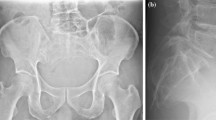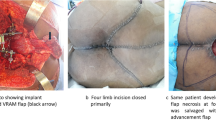Abstract
Emisacrectomy is a challenging surgery in the treatment of tumours that affect the sacrum. Authors report their experience in 11 cases affected by tumours of the sacrum (9 chordomas, 1 ependymoma, 1 monostotic bladder metastasis) operated on at the Orthopaedic Department of A.S.O S. Giovanni Battista Molinette in Turin, Italy, from 1998 through 2005 discussing planning surgery, level of osteotomy, functional and oncological results and complications of the treatment at a median follow-up of 5 years (range 2–9), describing the surgical and medical teaching learned from the treatment of these patients. Despite the potential complications, emisacrectomy can be performed successfully and is an important procedure in the treatment of sacral tumours.



Similar content being viewed by others
References
Stener B, Gunterberg B (1978) High amputation of the sacrum for extirpation of tumours. Spine 3:351–366
Campanacci M, Capanna R (1984) Pelvic malignancy—resection f the sacrum. In: Uthoff HK (ed) Current concepts and treatment of bone and soft tissue tumors. Springer, Berlin, pp 373–376
Murakam H, Kawara N, Tomita K, Sakamoto J, Oda J (2002) Biomechanical evaluation of reconstructed lumbosacral spine after total sacrectomy. J Orthop Sci 7(6):658–664
Tomita K, Tsuchiya H (1990) Total sacrectomy and reconstruction for huge sacral tumours. Spine 15:1223–1227
Wuisman P, Lieshot O, Van Dijk M, Van Diest P (2001) Reconstruction after total en bloc sacrectomy for osteosarcoma using a custom made prosthesis: a technical note. Spine 26:431–419
Sar C, Eralp L (2002) Surgical treatment of primary tumours of the sacrum. Arch Orthop Trauma Surg 122(3):148–155
Ziteli M, Hoscoskun C, Brastianos P, Sabah D (2003) Surgical treatment of primary sacral tumours: complications associated with sacrectomy. Neurosurg Focus 15(5):E9
Gokaslan ZL (2005) Bowel and bladder continence, wound healing and functional outcomes in patients who underwent sacrectomy. J Neurosurg Spine 3(2):106–110
Fourney DR, Rhines LD, Hentshel SJ, Skibber JM, Wolinsky JP, Weber KL, Suki D, Gallia GL, Garonzik I, Golaslan ZL (2005) En bloc resection of primary sacral tumours: classification of surgical approach and outcome. J Neurosurg Spine 3(2):111–122
Gennari A, Azzarelli A, Quagliolo V (1987) A posterior approach for the excision of sacral cordoma. J Bone Joint Surg 69B:565–568
Di Mauro D, D’Hoore A, Pennincks F, De Wever I, Vergote I, Hiener R (2008) V-Y bilateral gluteus maximus myocutaneous advancement flap in the reconstruction of large defects after resection of pelvic malignancies. Colorectal Dis 15(epub ahead of print)
Glatt BS, Disa JJ, Mehara BJ, Pusic AL, Boland P, Cordeio PG (2006) Reconstruction of extensive partial or total sacrectomy defects with a transabdominal vertical rectus abdominis myocutaneous flap. Ann Plast Surg 56(5):526–530
Junge K, Krones CJ, Rosh R, Fackeldey V, Schumpelick V (2003) Mesh reconstruction preventing sacral herniation. Hernia 7(4):224–226
Atkin G, Nmathur P, Ahrrion R (2003) Mesh repair of sacral hernia following sacrectomy. J R Soc Med 96(1):28–30
Berrevoet F, Pattyn P (2005) Use of bone anchors in perineal hernia repair: a practical note. Langenbecks Arch Surg 390(3):255–258
Hugate RR, Dickey ID, Phimolsarnti R, Yaszemski MJ, Sim FH (2006) Mechanical effects of partial sacrectomy: when is reconstruction necessary? Clin Orthop Relat Res 450:82–88
Kawara N, Murakami H, Yoshida A, Sakamoto J, Oda J, Tomita K (2003) Reconstruction after total sacrectomy using a new instrumentation technique: a biomechanical comparison. Spine 28(14):1567–1572
Todd LT, Yaszemski MJ, Currier BL, Fuchs B, Kim CW, Sim FH (2002) Bowel and bladder function after major sacral resection. Clin Orthop Relat Res (397):36–39
Guo Y, Palmer JL, Shen L, Kaur G, Willey J, Zhang T, Bruera E, Wolinsky JP, Gokaslan ZL (2005) Bowel and bladder continence, wound healing and functional outcomes in patients who underwent sacrectomy. J Neurosurg Spine 3(2):106–110
Ishii K, Chiba K, Watanabe M, Yabe H, Fujimura Y, Toyama Y (2002) Local recurrence after S2–S3 sacrectomy in sacral chordoma. Report of four cases. J Neurosurg 97(1 Suppl):98–101
Wells BJ, Stotland KO, Ko MA, Al-Sukhni W, Wuner J, Ferguson P, Lipa J, Last L, Smith AJ, Swallow CJ (2007) Results of an aggressive approach to resection of locally recurrent rectal cancer. Ann Surg Oncol 14(2):390–395
Conflict of interest statement
None of the authors has any potential conflict of interest.
Author information
Authors and Affiliations
Corresponding author
Rights and permissions
About this article
Cite this article
Solini, A., Gargiulo, G., Fronda, G. et al. Emisacrectomy, experience in 11 cases. Eur Spine J 18 (Suppl 1), 109–114 (2009). https://doi.org/10.1007/s00586-009-0993-x
Accepted:
Published:
Issue Date:
DOI: https://doi.org/10.1007/s00586-009-0993-x




